The imposition of kinesiology tape on the shoulder area
Acromioclavicular joint
1. In this case, we need two to four I-tapes. The length of the tape is 5-8 cm. Depending on the size of the area, the tape of standard width (5 cm) or semi-width (2.5 cm) is applied.
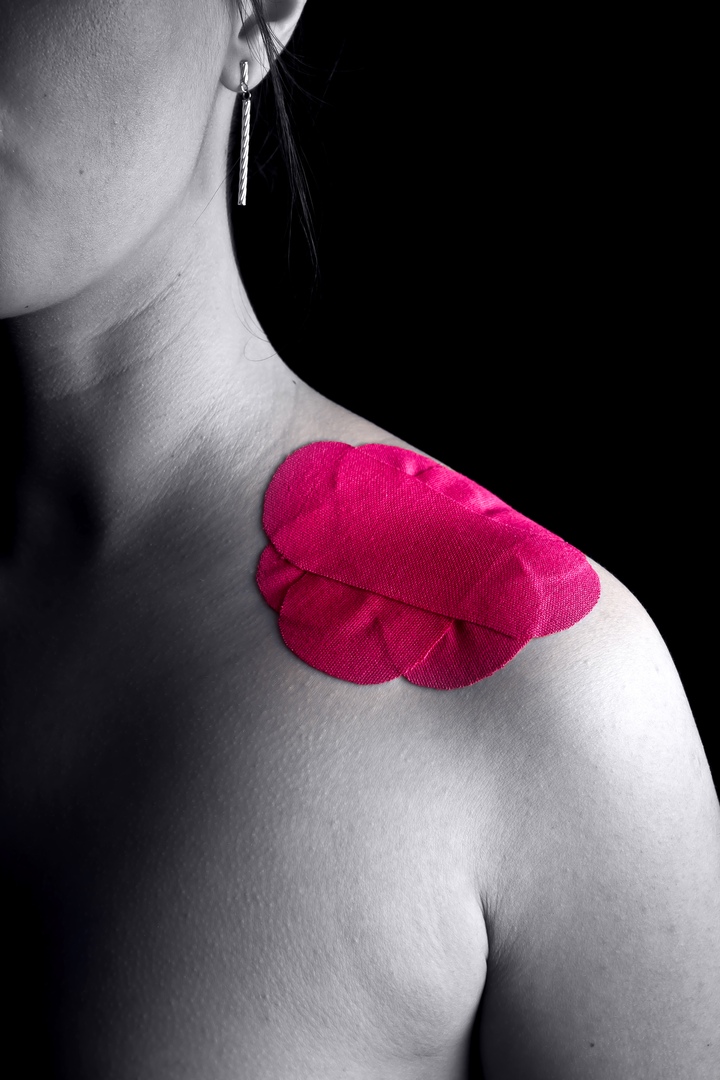
Indications: Injury of joint, shoulder instability, arthrosis of acromioclavicular joint
1. In this case, we need two to four I-tapes. The length of the tape is 5-8 cm. Depending on the size of the area, the tape of standard width (5 cm) or semi-width (2.5 cm) is applied.
2. Tear a sheet of paper at the centre and separate, leaving 1-2 cm along the edges.
3. Stretch the tape entirely and apply in the region of acromioclavicular joint. Apply tape ends without tension.
4. For Stabilisation of the joint, apply several strips of the tape as a criss-cross or star.
Latissimus dorsi muscle
4. For Stabilisation of the joint, apply several strips of the tape as a criss-cross or star.
Latissimus dorsi muscle

Indications: Correction of posture, trigger points, hypertonic muscles
1. This method requires two I-tapes. The length of tapes is different and directly depends an patient’s anatomic features.
2. Ask the patient for bending in lumbar spine and perform external rotation of the upper limb.
3. Apply the first tape with a 15 % tension from axillary space towards posterior part of iliac bone.
4. Apply the second tape also with a 15 % tension from crest of lesser tubercle of humerus towards Th10-Th12.
Teres minor muscle
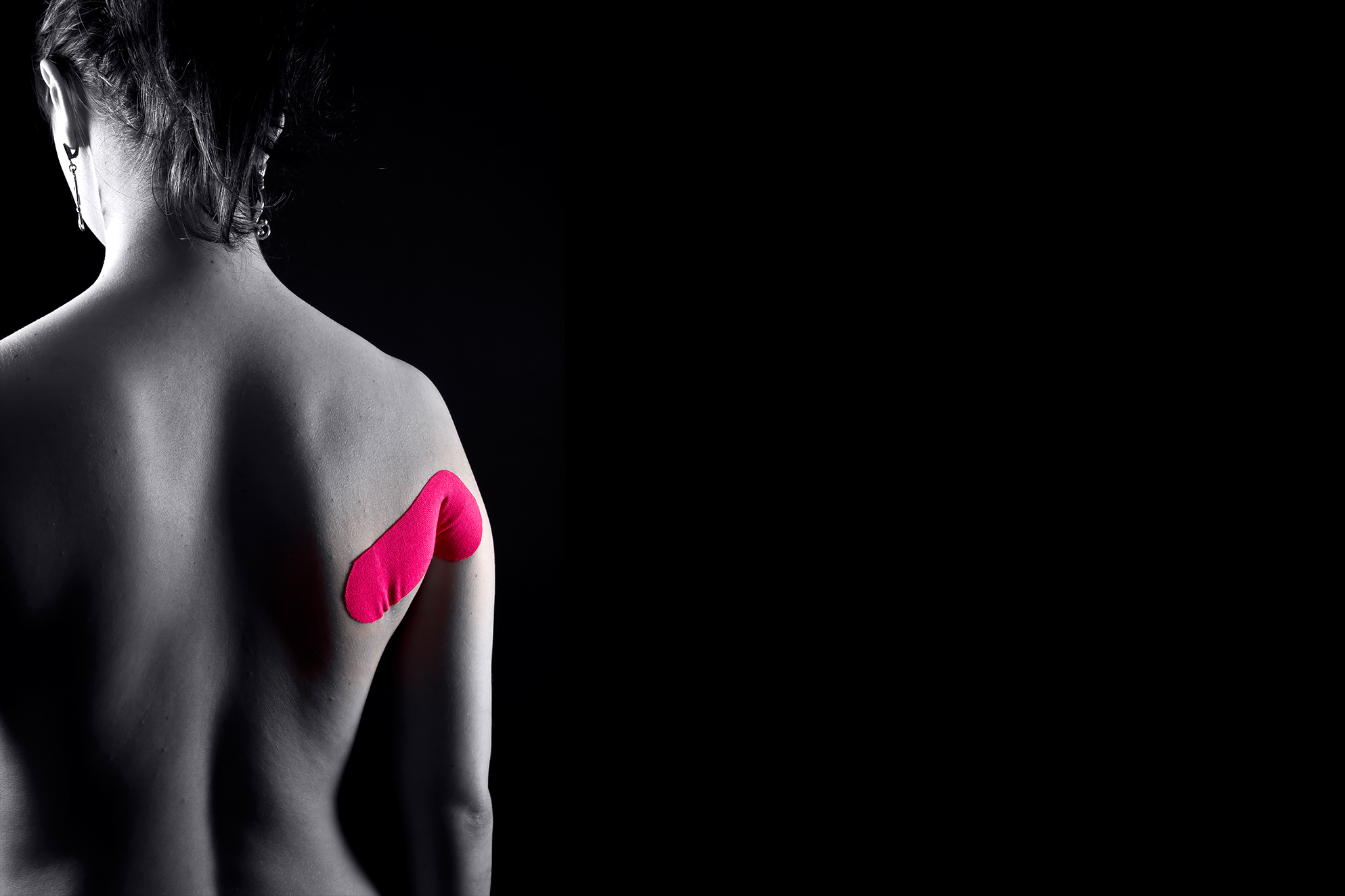
Indications: Hypertonic lesser terres muscle, trigger points
1. This method requires one I-tape of 15-20 cm long, depending on anatomic features of the patient.
2. Ask the patient to raise his/her arm for a maximal stretching of lesser terres muscle.
3. Apply the base of the I-tape in the region of lower scapular angle. Apply an operating part of the tape with a 15 % tension towards the crest of lesser tubercle of humerus.
Biceps of the arm
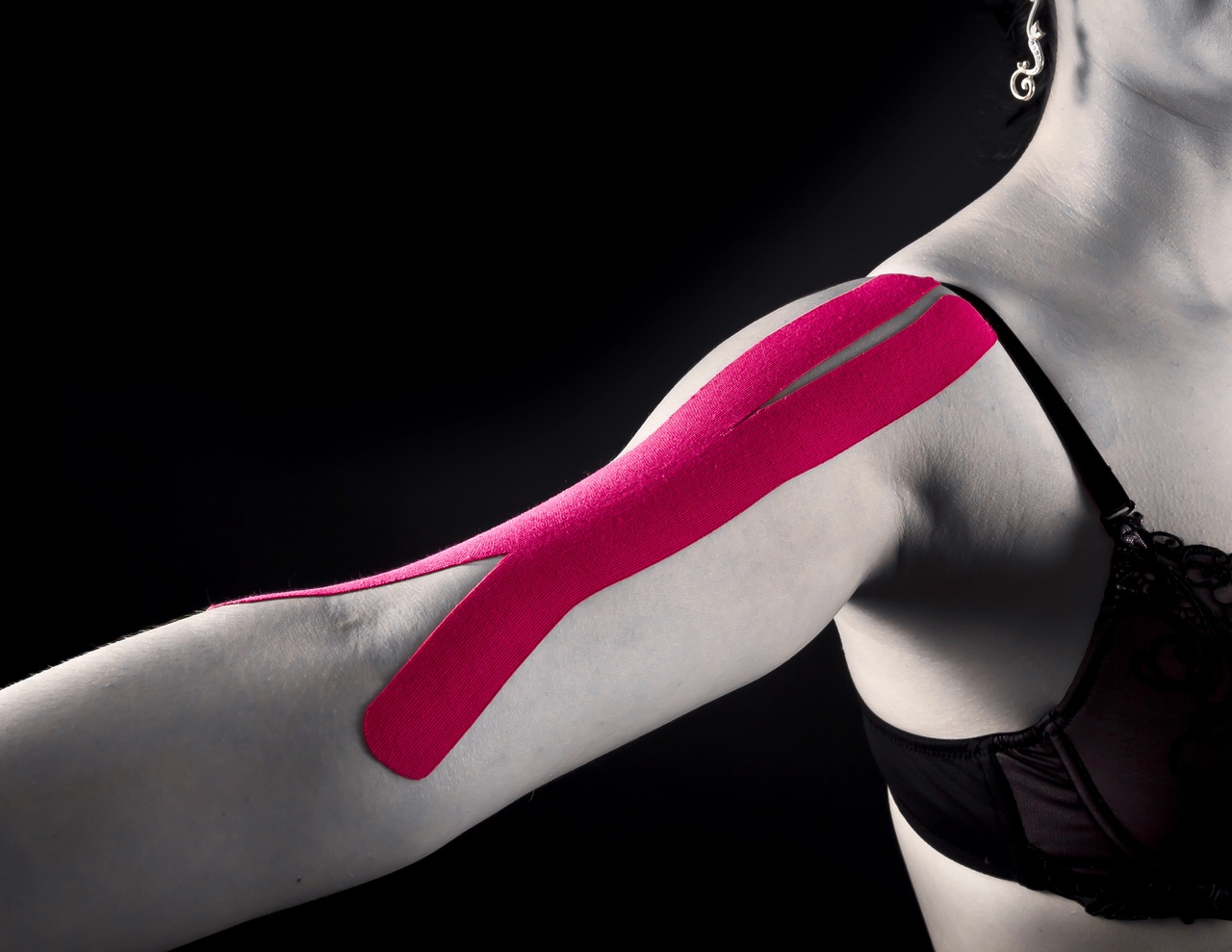
Indications: Tendinitis, hypertonic muscle, trigger points, traumatic epicondylitis
1. In this case, we need one X-tape approximately 20-23 cm long. The tape length directly depends on the patient’s anatomic features.
2. Split up both ends of the tape into two strips with equal length of 5-7 cm.
3. Apply the tape on the pulled muscle, therefore, ask the patient to extend his elbow and draw the arm in shoulder aside and slightly backwards.
4. First of all, apply tape bases — two strips in the region of the cubital fold. Then apply the tape along the anatomic shape of the muscle with a 15 % tension. Apply tape anchors without tension.
Rigid Stabilization of the shoulder joint
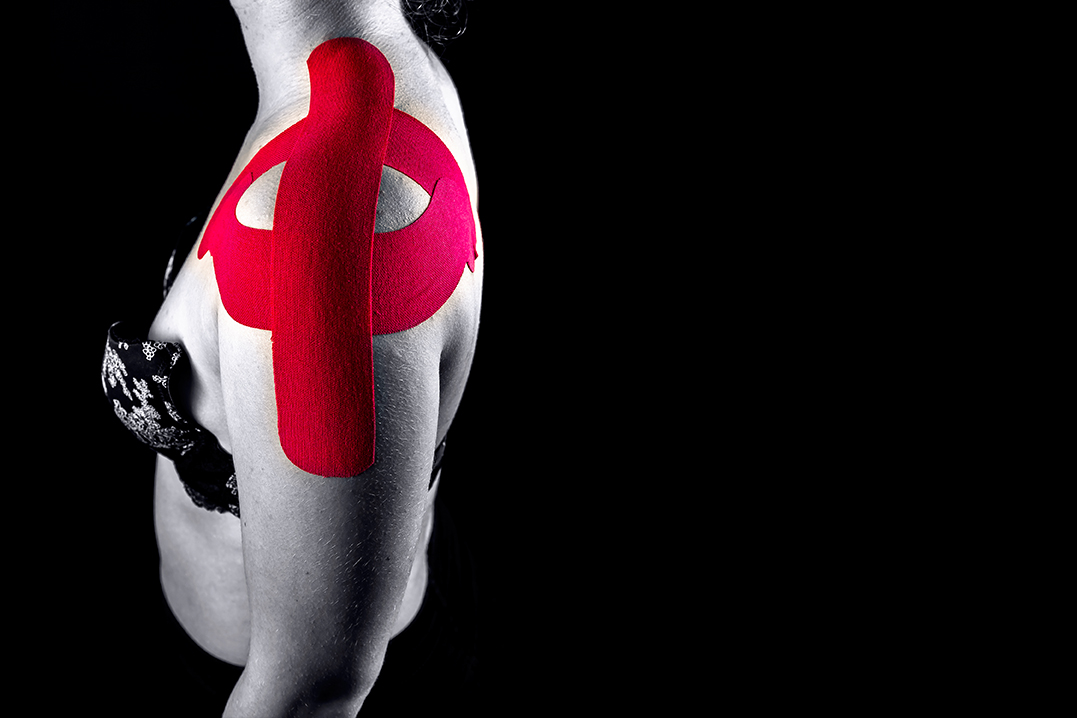
Indications: Instability of the shoulder joint
1. We need three I-tapes. The length of the first and second piece is about 20 cm and the length of the third one is 30 cm. The length of the pieces directly depends on anatomic features of the patient.
2. Upon application of the first tape, use ligament method. For muscular relaxation — the arm is abducted by 90 degrees in shoulder. Apply the tape on the upper part of the trapezius muscle. Apply the bases on the greater pectoral muscle and on the upper part of the lateral side of scapula.
3. Apply the second tape using ligament method on the deltoid muscle. Apply the bases over the bases of the first tape on the greater pectoral muscle and on the upper part of the lateral side of scapula.
4. The third tape (the length of 30 cm) is applied also using ligament method through a shoulder in perpendicular direction, crossing the first and the second tape.
Instability of the shoulder joint
Instability of the shoulder joint
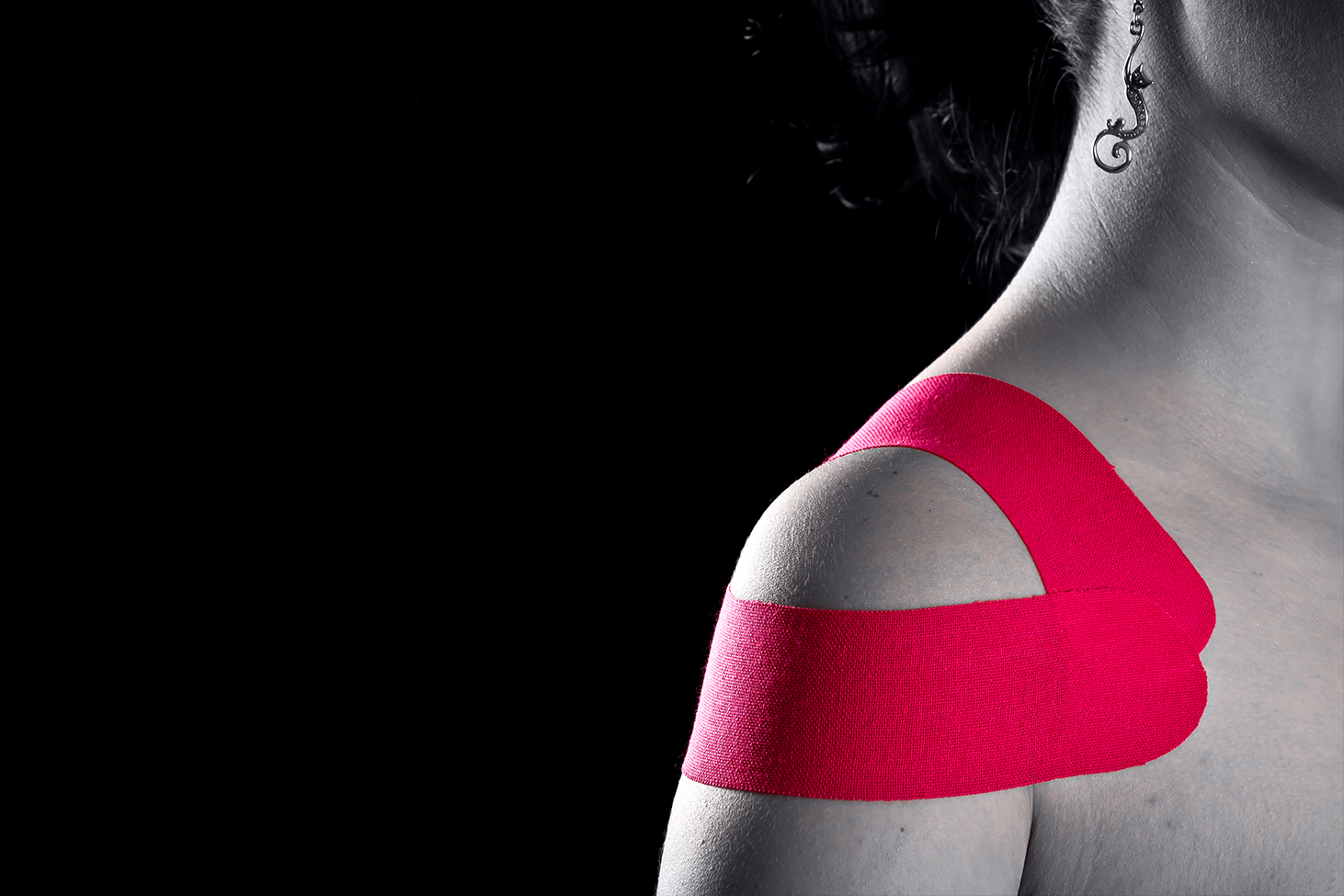
Indications: Stabilisation of shoulder
1. We will require two I-tape with the same length. The length is about 20 cm, depending on patient’s anatomic features. Perform the application around the shoulder.
2. Upon application of the first tape, use ligament method. For muscular relaxation — the arm is abducted by 90 degrees in shoulder. Apply the tape on the upper part of the trapezius muscle. Apply the bases on the greater pectoral muscle and on the upper part of the lateral side of scapula.
3. Upon application of the second tape, use ligament method as well. Apply the tape on the deltoid muscle. Apply the bases over the bases of the first tape on the greater pectoral muscle and on the upper part of the lateral side of scapula.
Infraspinatus muscle
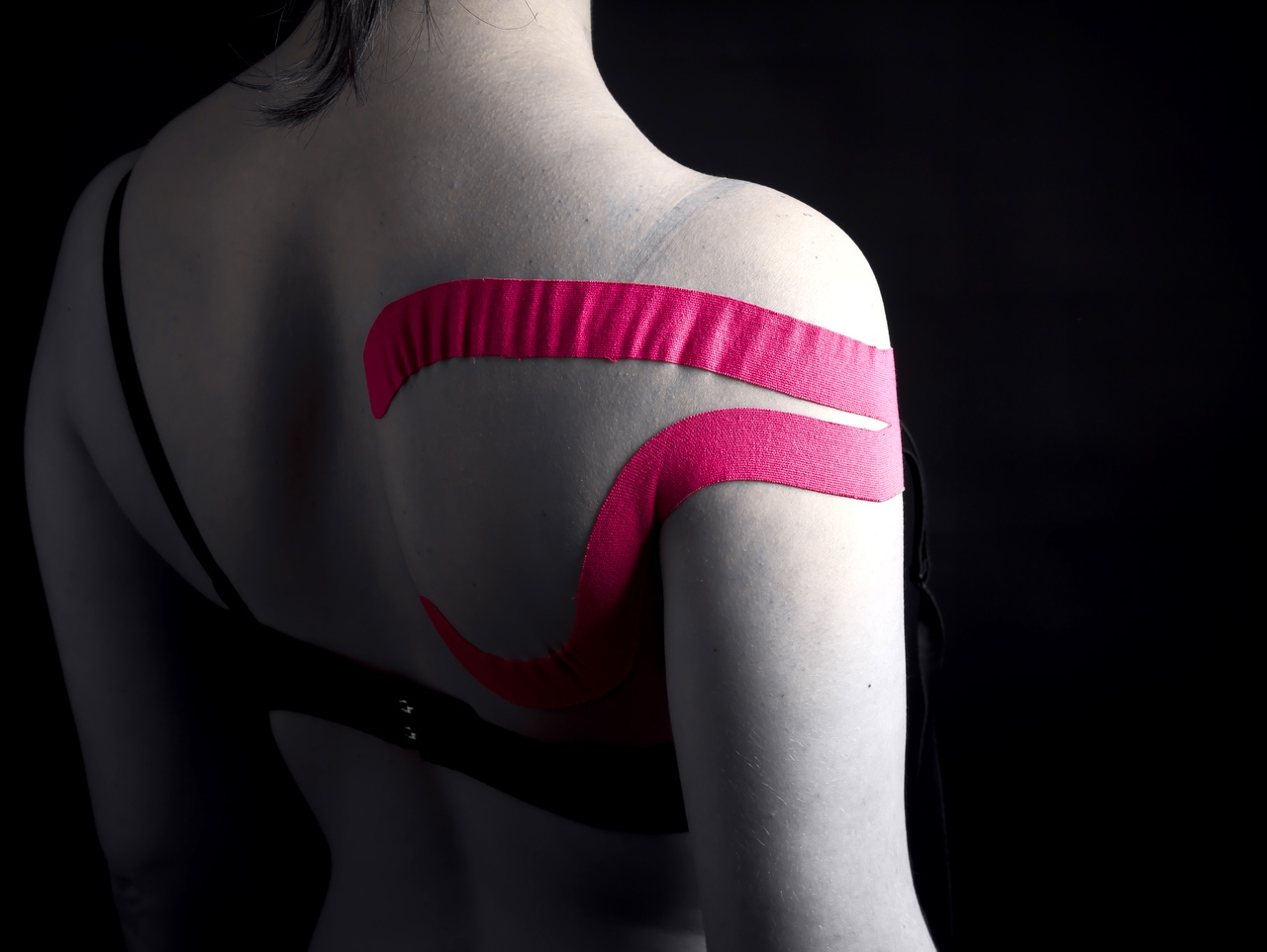
Indications: Hypertonic muscle, trigger points, scapulohumeral periarthritis, tendinitis
1. This method requires one Y-tape approximately 25 cm long. The length directly depends on the patient’s anatomic features.
2. Apply the base of the tape in the region of greater tubercle of humeri.
3. Apply strips of the tape in the position of internal rotation of the upper limb in the region of scapular body along the anatomic passage of muscle with a 15 % tension.
Supraspinatus muscle
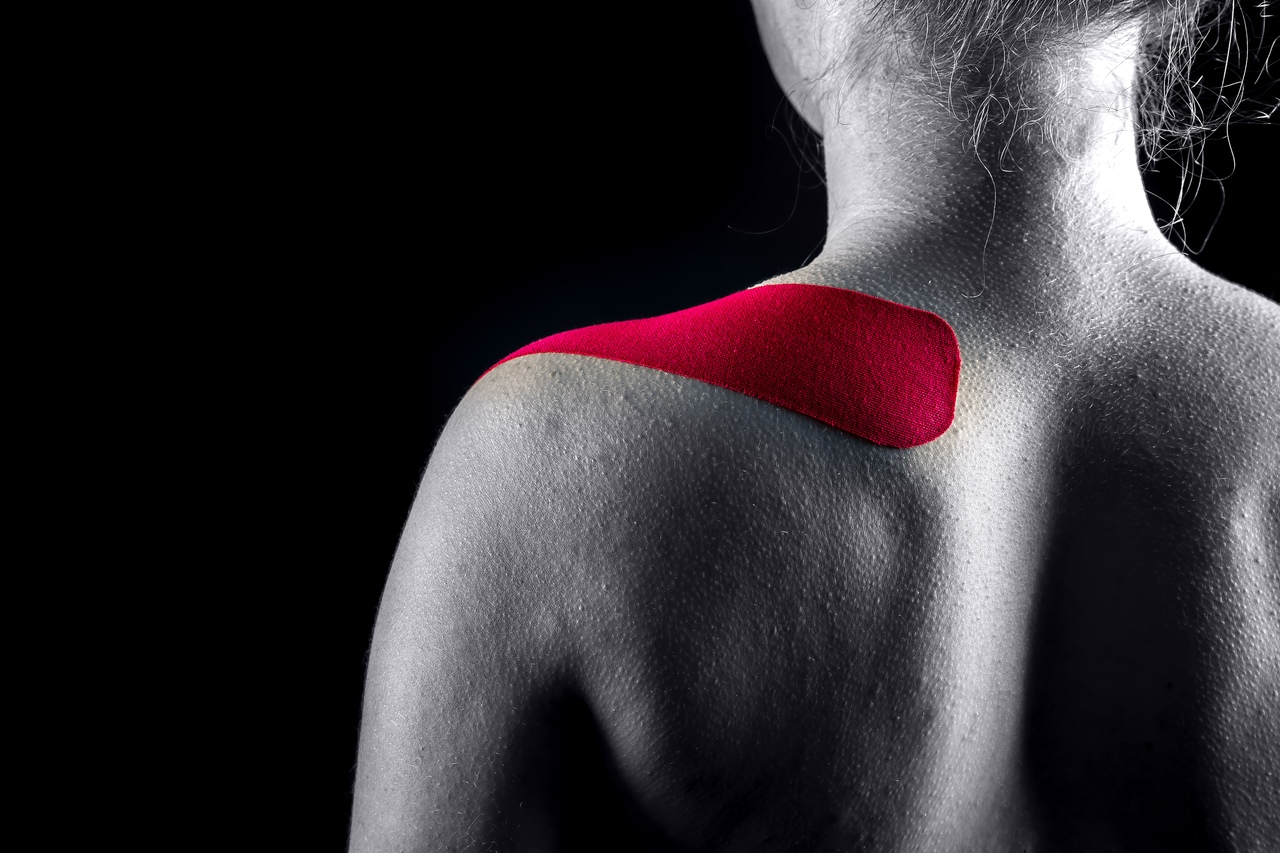
Indications: Hypertonic muscle, trigger points, tendinitis, subacromial bursitis, scapulohumeral periarthritis, shoulder instability
1. Measure and cut one piece of the tape approximately 15 cm long depending on patient’s anatomic features. Apply the tape in the projection of supraspinatus muscle.
2. Abduct the shoulder by 20-40 degrees and apply the base of the kinesiology tape on the greater tubercle of humeri.
3. Pressing the base of the tape with an arm, apply the tape horizontally around humeral head and then towards supraspinatus fossa with a 15 % tension.
Frozen shoulder
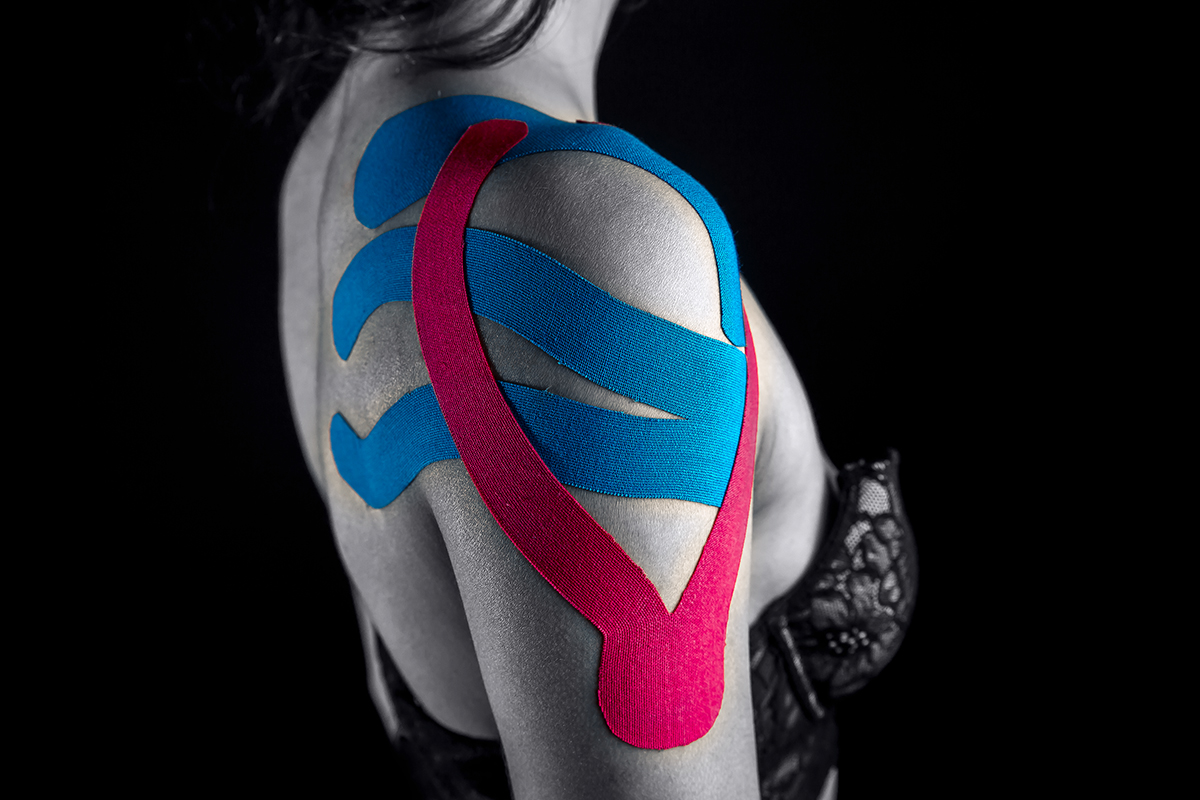
Indications: instability in shoulder joint, hypertonic muscle, injury of rotator cuff, impingement syndrome, trigger points
1. This combination of tapes consists of three separate applications: on supraspinatus, deltoid and infraspinatus muscle. This application requires one I-tape 15 cm long and two Y-tapes 20 cm long.
2. Before each application, position shoulder so that the tape is applied on the extended muscle. Apply all tapes with a 15 % tension.
3. Apply the first tape on supraspinatus muscle.
4. Abduct the shoulder by 20–40 degrees and apply the base of the kinesiology tape on the greater tubercle of the humeri. Pressing the base of the tape with an arm, apply the tape horizontally around humeral head and then towards supraspinatus fossa of the scapula.
5. Apply the second Y-tape on the infraspinatus muscle.
6. Apply the base of the tape in the region of the greater tubercle of the humeri. Apply strips of the tape in the position of internal rotation of the upper limb in the region of scapular body along the anatomic passage of muscle with a 15 % tension.
7. Apply the third Y-tape on the deltoid muscle.
8. Apply the base of the tape on the deltoid tuberosity. Upper limb is in its neutral position. For application of the first strip on the posterior fascicle of the deltoid muscle, we need to put a hand on the opposite shoulder and raise the elbow to the level of the clavicle. Then apply tape strip archwise towards the acromion. For application of the strip on the anterior fascicle of the deltoid muscle, ask the patient to abduct the upper limb posteriorly in the shoulder. In this position, apply the second trip archwise towards the acromioclavicular joint.
Stabilisation (sports-oriented) of the shoulder joint
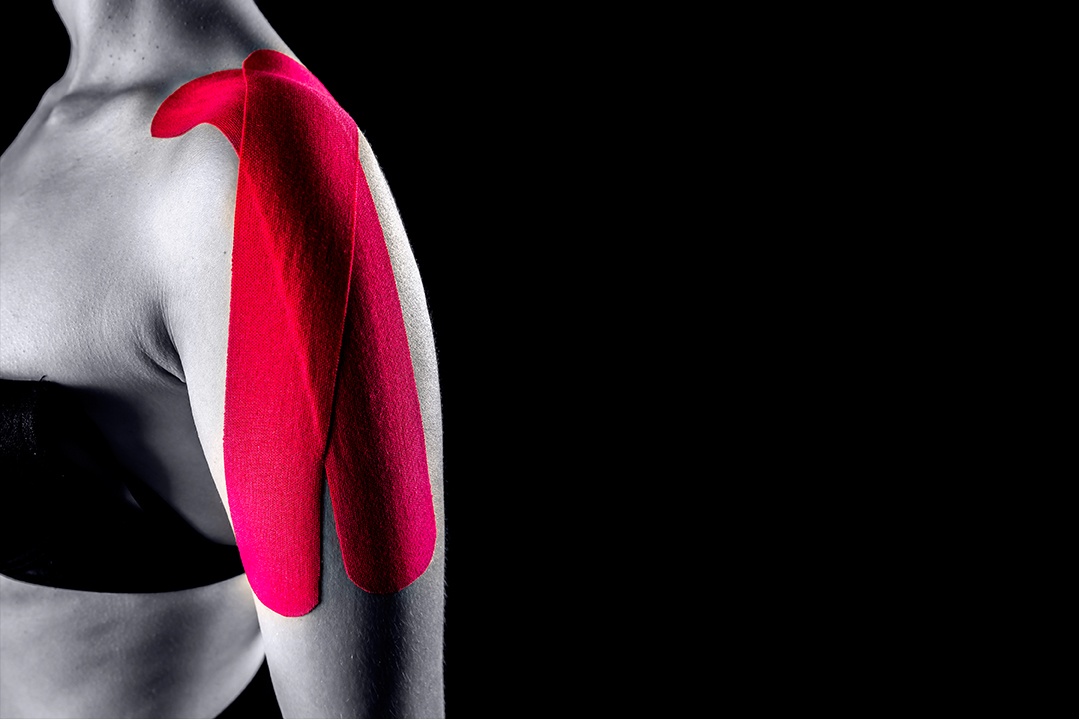
Indications: Instability of the shoulder joint
1. In this case, we need two I-tapes approximately 20 cm long. The length of the pieces directly depends on the patient’s anatomic features.
2. Apply the first tape on the shoulder using ligament method, the arm is abducted by 90 degrees in the shoulder joint.
3. Apply the second tape also using ligament method through the shoulder joint, criss-crossing the first one.
4. Apply the tape ends without tension.
Shoulder bursitis
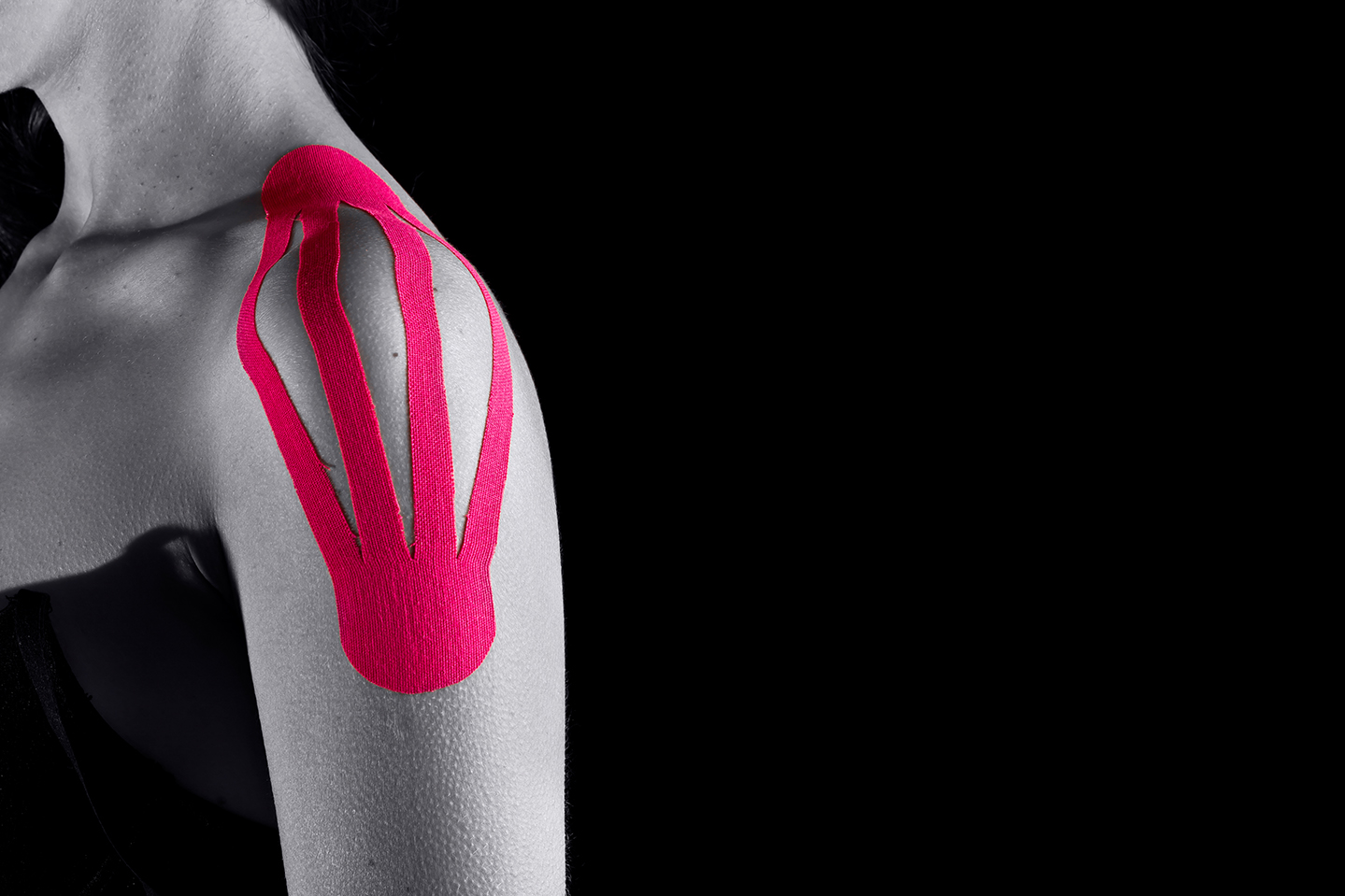
Indications: Shoulder bursitis, pain in the joint
1. In this case, we need one piece of tape 13-15 cm long.
2. After rounding of the ends, double up the tape and cut it by strips. The ends (about 3 cm on each side) are left integer.
3. Apply both bases of the tape proximally and distally to the shoulder.
4. Bend the limb to the maximum in the shoulder joint and apply strips of the tape in the region of shoulder and on its sides.
Acute injury of the shoulder joint
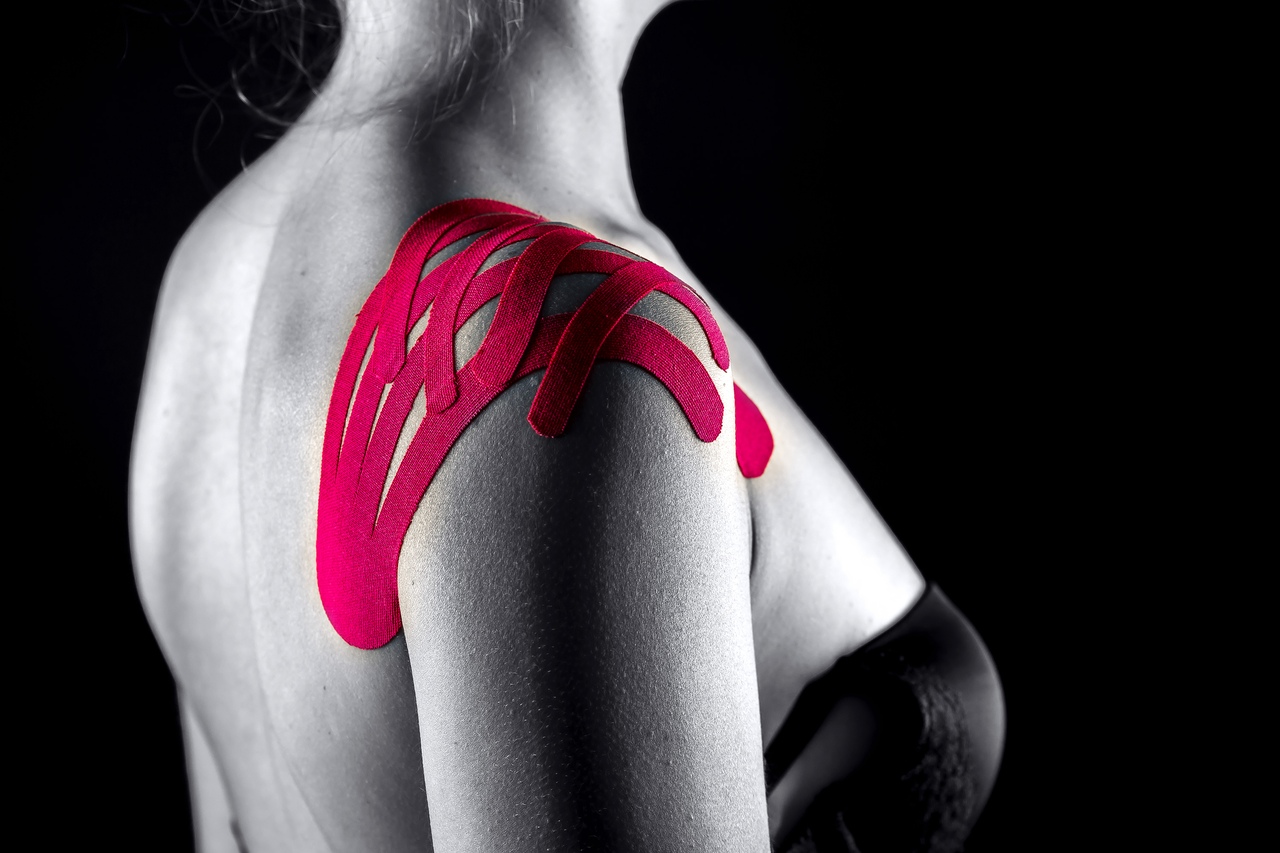
Indications: Soft tissue bruise, acute injury of the shoulder joint (swelling)
1. Cut off two tapes approximately 15 cm long. Cut the tape into 4-5 long strips. The tape base is 4 cm, and it is left integer. The width of cut tape strips should be 0.7 cm to 1.5 cm.
2. Apply the body of the tape without tension towards the nearest frontal lymph node. In this case, these are axillary lymph nodes.
3. Apply the strips on the skin with a maximal tension.
4. Apply the second tape using the same method on the dorsal side so that strips cross each other over the shoulder. If haematoma or swelling are present, perform application in the region of the problem.
Deltoid muscle
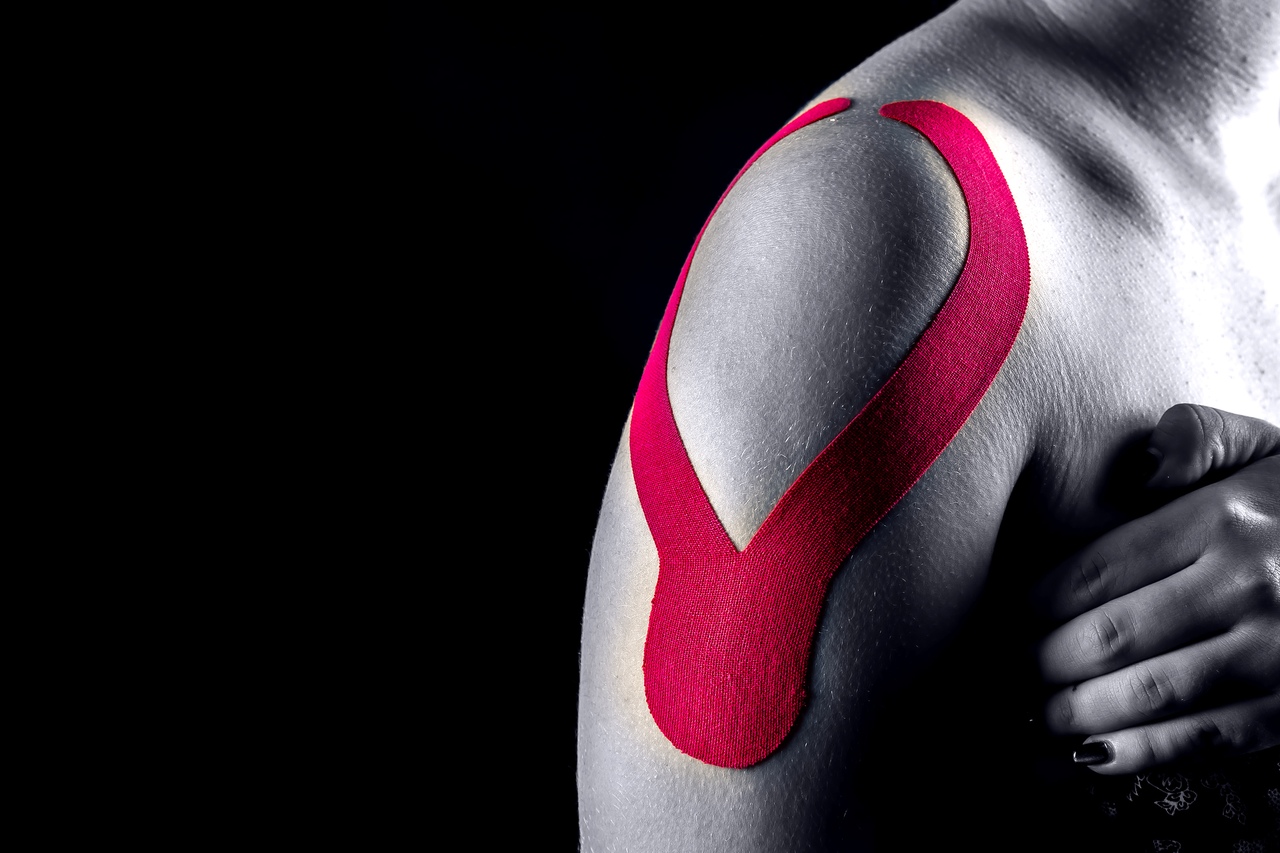
Indications: Hypertonic muscle, trigger points
1. In this case, we need one Y-tape approximately 15-20 cm long. The tape length directly depends on the patient’s anatomic features.
2. Divide the tape on one side into two parts equal in width, and the tape base is 3-4 cm, and is left integer.
3. Apply the base of the tape on the deltoid tuberosity. Upper limb is in its neutral position
4. For application of the first strip on the posterior fascicle of the deltoid muscle, we need to put a hand on the opposite shoulder and raise the elbow to the level of the clavicle. Doing so, we stretch posterior fascicle. Then apply the tape arch-wise with a 15 % tension towards the acromion, according to the anatomic passage of posterior fascicle of the deltoid muscle.
5. For application of the strip on the anterior fascicle of the deltoid muscle, ask the patient to abduct the upper limb posteriorly in the shoulder. In this position, apply the second strip arch-wise with a 15 % tension towards acromioclavicular joint, according to the anatomic passage of anterior fascicle of the deltoid muscle.
Triceps of the arm
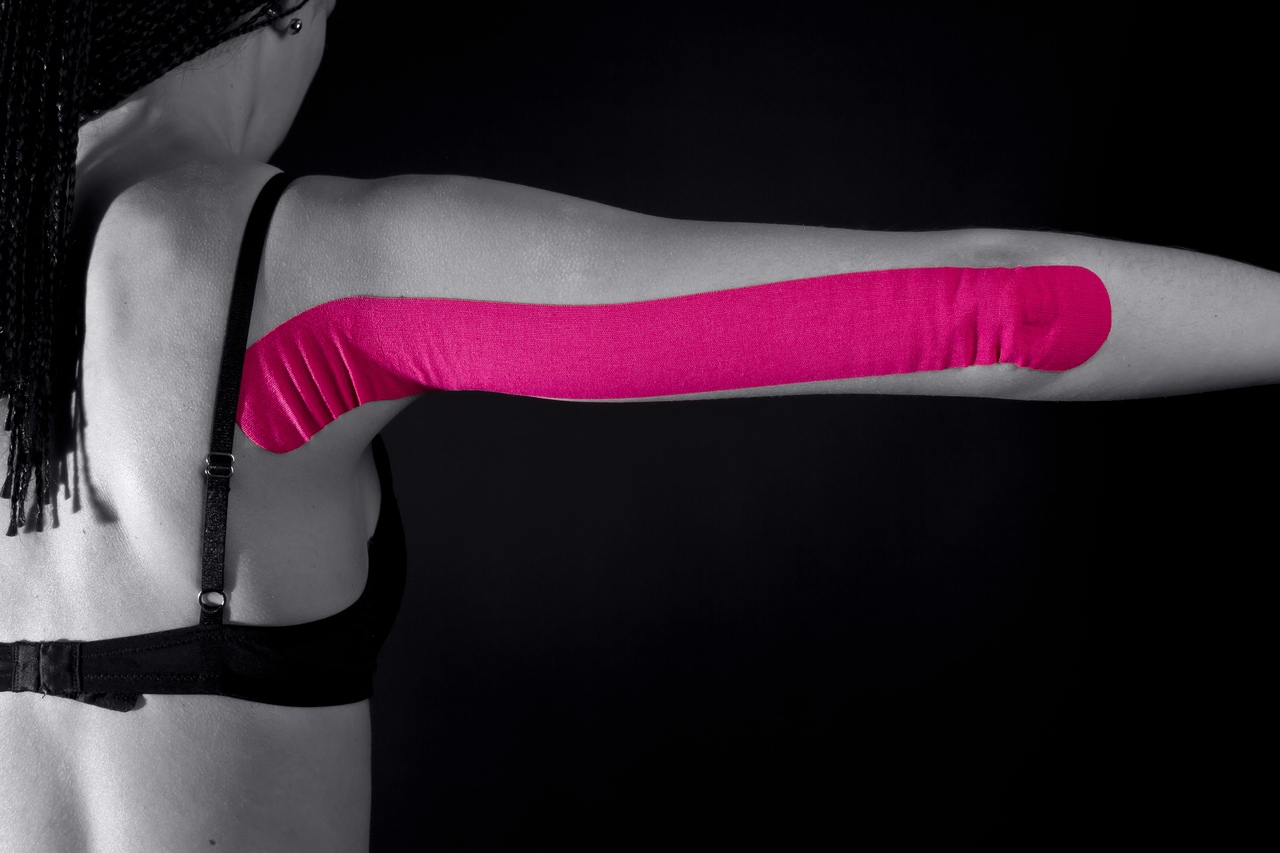
Indications: Trigger points, tendinitis, radiating pain, hypertonic muscle
1. This method requires one I-tape approximately 40 cm long.
2. Ask the patient for maximal extension of his/her arm in the elbow. Apply the base of the tape without tension on the olecranon.
3. Ask the patient for maximal raise of his/her hand upwards. Apply the tape with a 15 % tension to the place of muscle insertion on the infraglenoid tubercle.
March 2020
April 2020
May 2020
 Shopping cart (0)
Shopping cart (0)
